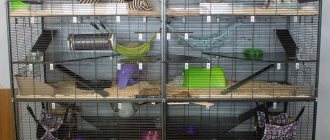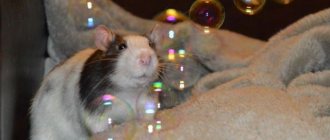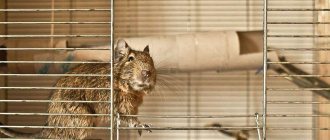The first question that arises when deciding to get a decorative rat is where to place the new pet. A rat cage is the main element that provides comfortable and safe living conditions for the animal. Many owners let their pets roam freely around the room, but even in this case, a place is needed that the animal will consider as its personal territory, where it will feel calm. Lattice walls will also provide additional protection if there are other animals in the apartment - a dog or a cat. An important factor is the ease of cleaning - in the absence of a cage, the room will inevitably suffer from contamination.
Features of a cage for domestic rats
For conscious rodent owners, a rat cage is a safe space, a home and a small gym. Before choosing a cage for your pet, take a few minutes to learn about the features of a cage that is suitable for large rodents.
- Cage material
Rat cages can be made from a variety of materials, including metal wire, plastic, and wood. Considering that your rat will be living, eating and drinking inside the cage, consider choosing a material that is odor-resistant and durable enough to withstand damage in case your furry companion decides to chew on the cage.
Metal is the best cage material for rats because it is inexpensive, durable, and chew-resistant. However, if you choose a metal cage, make sure it will not rust over time. It must be treated with a special anti-corrosion coating.
Plastic and wood can be good options for ramps or for lining the bottom of the cage, but keep in mind that both of these materials can be chewed by your pets. To prevent this from happening, make sure your rats are happy and entertained with innovative climbing structures, chew toys, and daily outside play.
- Distance between rods
Rats can fit through very small spaces. So, if the gap between the bars in your cage is large enough for your rat's head, he will be able to escape. To keep your pets safe while you're away, look for a rat cage with a door that has a secure locking mechanism.
For small rats you will need a cage with 1cm spacing between the bars. Adult rats can be kept in cages with wider bar spacing, but it is not recommended to rely on cages with bar spacing greater than 2 cm.
When you choose a location for your rat cage, make sure it is:
- away from windows and drafts;
- away from direct/constant sunlight, although the room will require a natural source of daylight;
- safe from other pets such as cats and dogs;
- safe from small unattended children;
- away from constant loud noise, such as a TV or music system;
- in a family friendly place to provide plenty of socializing.
Keeping decorative rats, what you should pay attention to.
The existing features of caring for domestic rats are caused by the excessive sensitivity of their respiratory system. In addition, this rodent is a carrier of mycoplasma, which is reduced or activated when the animal is not properly cared for.
Basic requirements for keeping rats at home:
- The animal's bedding should not become dusty, so it is important to constantly monitor its cleanliness. It is best to choose a soft cloth as a bed for a rat. Some pet owners prefer to use special litters offered by modern pet stores. In such cases, it is advisable to install a false bottom in the cage - a structure that is a lattice installed at a short distance from the floor of the cage. This installation will prevent the rat's nose from coming into contact with dust accumulated in the litter.
Cleaning the cage requires regular care and keeping it clean and tidy, which will protect the animal from many diseases, since the excrement of a decorative rat contains a large amount of ammonia, which has a detrimental effect on its respiratory system.
The cage with the animal should be located far from drafts and heating equipment. Heaters dry out the air excessively, making it difficult for the rodent to breathe, and a slight draft can cause the animal to catch a cold.
One of the unfavorable factors affecting the health of a pet rat is dry air, so it is advisable to get an air humidifier. It should be placed in the room where the animal’s cage is located. You can also spray the room with a spray bottle or hang a damp cloth on the rodent's cage.
If the room is cold, you should not resort to using heaters. It is enough to give the rat warm rags, from which it will make itself a cozy nest.
What should the cell size be?
Most pet rats spend most of their time in a cage—sometimes up to 22 or 23 hours a day. So, it should be spacious enough to give the rats enough space to explore and be active.
The exact size of the cage depends on the number of rats you have. Its goal is to provide rats with a complete habitat with many different areas to dig, climb, run, sleep and forage for food. The standard cage size for one or two rats is 72cm x 36cm x 44cm, but if you have more rats you will need to choose a larger size.
When choosing a cage for two or three rats, keep these minimum dimensions in mind:
- Depth: 80 cm
- Width: 50 cm
- Height: 80 cm
If you plan to keep a group of 10 rats, remember the following minimum sizes:
- Depth: 93 cm
- Width: 63cm
- Height: 123 cm without stand
There are several starter cage types that may be a good choice if you have little rats. But you need to keep in mind that rats grow quite quickly and will outgrow their small cage in 3-4 months. It will probably be better to buy an adult rat cage outright and save money.
When it comes to rat cage size, it is best to choose a larger cage. Rats need a lot of space to roam, climb and play, so they will be unhappy living in a small cage. More is always better! However, large cages are only beneficial for rats if they are well designed and the space is put to good use. Proper cage installation is just as important as choosing the right size cage.
Hygienic requirements for cages
The well-being, behavior and mood of the pet depend on the characteristics of the home. A purchased or self-made house must meet a number of requirements:
- The cage for the rodent should be large enough - preferably multi-story. Rats are very active animals, it is important for them to be able to move freely, climb and jump. The volume of the house should be at least 50 liters, the size of the cage at the base should be from 2400 cm², and the height should be from 50 cm.
- The distance between the rods is no more than 1.5 cm for average-sized rats.
- It is important to take care of strong locks on the doors in advance.
- Instead of a bottom, a tray is used. The most convenient option for the owner is a retractable one. The box can be pulled out and cleaned at any time, and you can also put filler in it. A fine-grained mesh is placed on top of the pallet.
Important! To determine the optimal size of your home, use a cell calculator. It will help you understand whether a given cage is suitable for rodents, as well as how many rats can comfortably fit in it.
How to set up a rat cage
Your rat cage should include features and functions that make your pet easier to care for and also keep him happy. For example, some cages come with removable food and water containers that can be filled and replaced without removing the rodent from the cage.
Rat cages require the following accessories:
- Containers for food and water.
It is better to choose a bowl made of ceramic material of medium and small size, intended for small animals. Always place the bowl away from the sides of the cage to prevent it from falling and crushing one of your pets. Make sure it is not located under the water bottle, otherwise water will drip and spoil the food. - Houses.
Sometimes rodents like to be alone and a house is perfect for a rodent's privacy. - Hammocks.
Rats love sleeping in them and encourage them to have grooming sessions with their cage mates and feel relaxed around you. Hammocks can be bought or homemade from old jumpers, towels and sheets. - Tray.
These pets can be taught to go to the toilet in a certain place. It is worth purchasing a tray, as well as a safe filler for it.
Best Cages for Gerbils
In nature, gerbils live in the desert, so it is not easy to recreate living conditions acceptable to them. Regular rodent cages do not cope with this task. It is best to choose spacious two-tier structures consisting of a glass terrarium and a terrace with a metal lattice.
A lot of sawdust is poured into the aquarium so that the gerbils dig deep tunnels, and a relaxation area is arranged on the terrace. For breeding gerbils, one-story containers with plastic or glass walls and a lattice roof are used.
Ferplast cage for gerbils Gabry 50 (glass, metal)
5
★★★★★
editorial assessment
100%
buyers recommend this product
The Gabry glass two-level cage is an ideal option for keeping a gerbil. The walls of the first floor are made of durable glass; below there is a deep tray for sawdust.
An iron staircase leads to the second tier. There is a lattice metal terrace there. The model is equipped with a drinking bowl and a drinking bowl. Dimensions of the cage: 52x27x44 cm.
Advantages:
- two spacious floors;
- safe door opening and closing system;
- easy access to the cage;
- quality materials.
Flaws:
- high price.
Ferplast Gabry provides good ventilation. All its parts are firmly connected to each other - the cage is designed for long-term use.
Inter Zoo Cage-terrarium G120X ALEx
4.9
★★★★★
editorial assessment
95%
buyers recommend this product
The ALEx Inter Zoo cage is a collapsible plastic container with rounded walls. The bottom of the container is black, the top is transparent. A metal grille is installed on the roof to ensure sufficient air flow. It is fixed with special clips, which can be unfastened to remove the roof to play with the animal or clean the cage.
Advantages:
- high-quality plastic;
- fine grate;
- removable tray;
- capacity.
Flaws:
- no carrying handle.
The spacious cage, 58x25x38 cm, accommodates a feeder, a drinking bowl and the gerbil's favorite toys.
Tetra Zooexpress terrarium large with plastic door
4.8
★★★★★
editorial assessment
90%
buyers recommend this product
The Zooexpress terrarium consists of a transparent plastic dome that acts as side walls and a roof. At the top there is a ventilation grille, secured on the sides with latches, and at the bottom there is a colored tray. The accessory is sold together with a drinking bowl, food bowls and original toys. Cage dimensions 42x30.5x22.5 cm, weight 1.3 kg.
Advantages:
- streamlined shape of the terrarium;
- safe manufacturing materials;
- weighs little;
- good equipment;
- affordable price.
Flaws:
- plastic bowls that gerbils quickly chew on.
Tetra Zooexpress is recommended not only for gerbils, but also for ornamental mice, degus and aquatic turtles.
Toys and exercise equipment in the cage
Just as you have many items in your home designed for your entertainment, your rat's home should have accessories that will help him exercise, relax, and have fun. Consider a rat cage that includes a hammock for rest and relaxation, plenty of tubes or ropes to climb on for exercise, and rat toys to keep your pet entertained.
Your rats will love:
- Pipes and tunnels for passage
. - Climbing towers
, such as metal CD towers. - Ropes
. You can make them yourself or buy ready-made ones. - Wheel
. It should be large and durable, designed specifically for rats. - Cardboard boxes of all shapes and sizes
. Make some holes in them to make exploring even more fun. Old jumpers, socks and soft hats are always welcome as bedding for your rats.
It is important to know!
Never give rats plastic toys that have been treated with varnish, perfume, glass cleaner or oil.
What designs cannot be used
A rat cage can be made from improvised materials, but there are items that are completely unsuitable as building materials. These are any glass structures - jars, aquariums, terrariums. Staying in such a house is very dangerous for health - the animal will suffer due to the lack of fresh air.
Plastic containers are not suitable for the animal’s permanent habitat for the same reason.
Cages that are too small for ferrets or mice - flat or one-story - are also not suitable for a pet rat. Due to their more active lifestyle, these animals need to exercise their muscles by moving between levels, climbing on bars and special devices. Small passages can cause injury to the rodent.
Choosing the right litter for rats
Using the wrong litter for rats can have a very negative impact on their health. Wood shavings or sawdust can be extremely harmful to your rats' skin and respiratory tract and can also cause an allergic reaction.
Filling materials that are safe for rats:
- Finely chopped, shredded paper;
- Shredded cardboard suitable for the base of the cage;
- Hemp is odorless;
- Cardboard squares are about 1 cm in size, ideal for the base of the cage;
- Fleece or towels can be used in sleeping areas or as hammocks;
- Paper granules.
Proper cage care
Keeping your rat cage clean is key to preventing serious illnesses such as respiratory illnesses and painful paw infections. Clean your rats' litter trays or litter trays daily, rinse any soiled areas with pet disinfectant, and wipe dry with wipes.
Perform a thorough cleaning of the entire cage once a week, making sure to also clean all toys and exercise equipment with a rat-friendly disinfectant. Machine wash hammocks and any other fabric using non-biological detergent at 60°C to kill as many bacteria as possible.
Take the opportunity to add a few new toys to the cage for interest, such as a new tunnel, hammock or rope ladder, cardboard boxes filled with something are also great for rats to explore.











